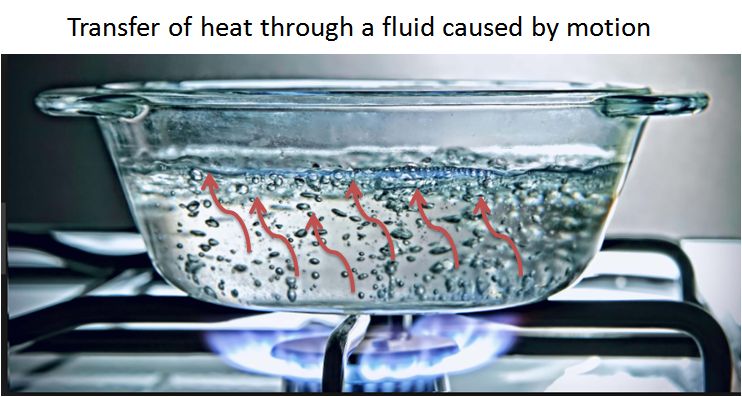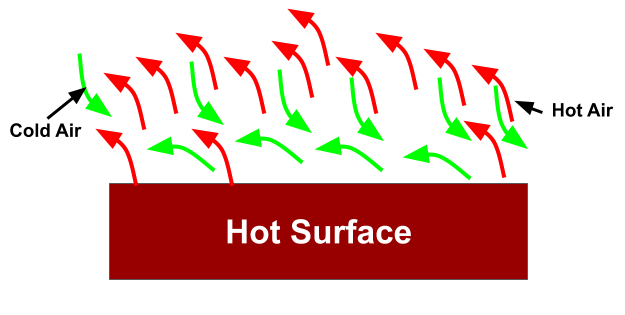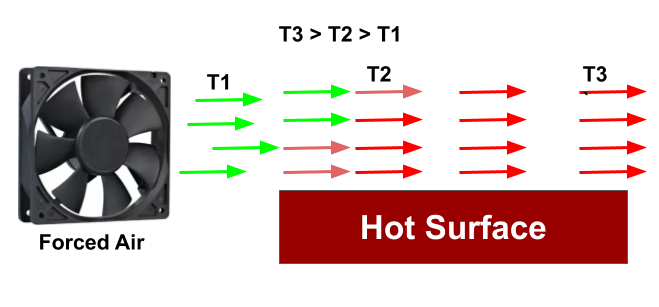What is Convection Heat Transfer?

Transfer of heat from one place to another due to the molecular movement of fluids such as air or liquid is known as convective heat transfer.
When air molecules move from one place to another, they carry heat energy. For example, an air conditioner cools a space by cooling the room’s inside air and removing hot air. The room cooling rate depends on the following parameters.
- Cooling air velocity and temperature
- Cooling space area
- Room existing temperature.
This mode of heat transfer is known as Convection Heat Transfer. Therefore higher the rate of convective heat transfer, the higher will be the rate of room cooling. In this article, we will discuss what convection heat transfer is? its types and how to calculate convective heat transfer?
Newton's Law of Cooling : Convective Heat Transfer Calculation
According to Newton’s law of cooling, the Rate of convective heat transfer is directly proportional to heat transfer surface area, convective heat transfer coefficient, and temperature difference. Here the valve of Convective heat transfer coefficient depends on the flow type.
Convective Heat transfer (Qv) = hc A dT
where
Qv = Convective heat transfer per unit time in Watt.
A = Heat transfer area in a square meter.
hc= Convective heat transfer coefficient (W/m² K).
dT = Temperature difference.
Types of Convective Heat Transfer
According to the flow type, we can classify convective heat transfer into the following types.
- Free / Natural Convection
- Forced Convection
1. Natural Convection
Natural convection is the heat transfer due to the movement of liquid or air molecules. Molecular movement occurs due to density difference, which is a function of temperature.
Force generated due to the liquid or air molecules density difference is known as buoyancy force. Natural Convection occurs without external sources such as a pump or fan.
How Natural Convection Heat Transfer Works?
In natural convection, hot fluid or air rises, and cold air comes in place of hot air. In this way, this cycle continues till equilibrium. The direction of gravity has an impact on natural convection because molecules need to rise against gravitational force.

For example, when cold air comes in contact with a hot object. Air temperature near the hot surface rises, whereas hot body temperature decreases. This Increased air temperature results in a decrease in air density.
Due to gravitational forces, high-density cold air comes downward and replaces the hot air. This cycle continues till the complete system comes into equilibrium.
From the above example, we can conclude that the hot air rises upward whereas cold air moves down. One of the best examples is a refrigerator where the refrigeration unit is in the upper section.
Examples of Natural Convection heat Transfer
Natural convection plays a role in natural phenomenon on earth and engineering applications. Following are the natural convection heat transfer examples.
- Cyclones.
- Underwater currents.
- Movement of clouds.
- Space heating using radiators.
- Water heating.
- Cooling in refrigerator
- Convective heating in the microwave.
- Cooling of electronic units and appliances etc.
2. Forced Convection
In Forced convective heat transfer, the flow of fluid or air is due to an external force such as a fan or pump. Forced convection increases the rate of heat transfer compared to natural convection.
The rate of heat transfer in forced convection depends on the velocity of air. The higher the air velocity, the higher will be the rate of heat transfer.

Forced convection involves fluid motion as well as conductive heat transfer. For example, an air conditioner cools a room by forced convection. If we increase AC fan speed, the room cooling rate will also increase because of an increase in the heat transfer coefficient.
Forced Convection Application Examples
Following are examples of forced convection heat transfer.
- The flow of coolant in a car engine.
- Cooling of laptop or PC processor using a fan.
- Heat exchangers.
- Air conditioning units
- Hairdryer
- Cooling of electronic devices such as servers.
- Car Radiator etc.
Convective Heat Transfer Coefficient
The value of the Convective heat transfer coefficient (hc) depends on the type of media (gas or liquid), Flow velocity, and temperature difference.
Convective Heat Transfer coefficient for Air
Natural Convection = 5 – 25 W/m² K
Forced Convection = 10 – 200 W/m² K
Formula for Convective heat transfer coefficient Calculation. (for air)![]()
v = Relative speed of the object through the air. This formula works for a velocity range of 2 to 20 m/s.
Convective Heat Transfer Calculator
To sum up, Convective heat transfer occurs in liquid or air because of the movement of molecules from a hotter place to a colder place. And to improve convective heat transfer, use forced convection.
We will keep updating this article on convective heat transfer. Add your suggestions, comments, or questions in the comment box.

Space heaters that utilize liquid or gaseous fuel are also an option. These types of heaters are a great way to save on your heating bill. The best thing about these types of heaters is that they are very efficient and do not store any heat.